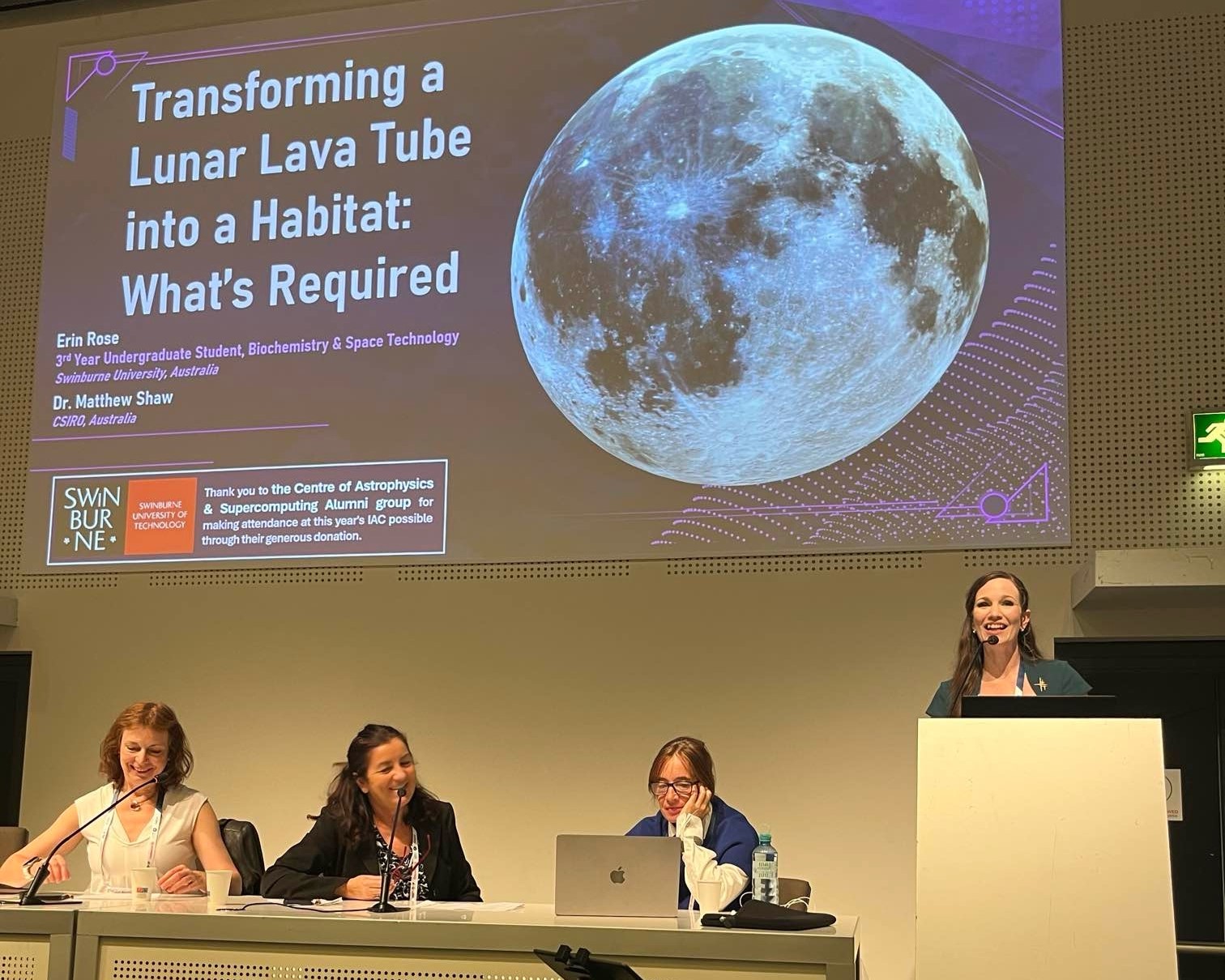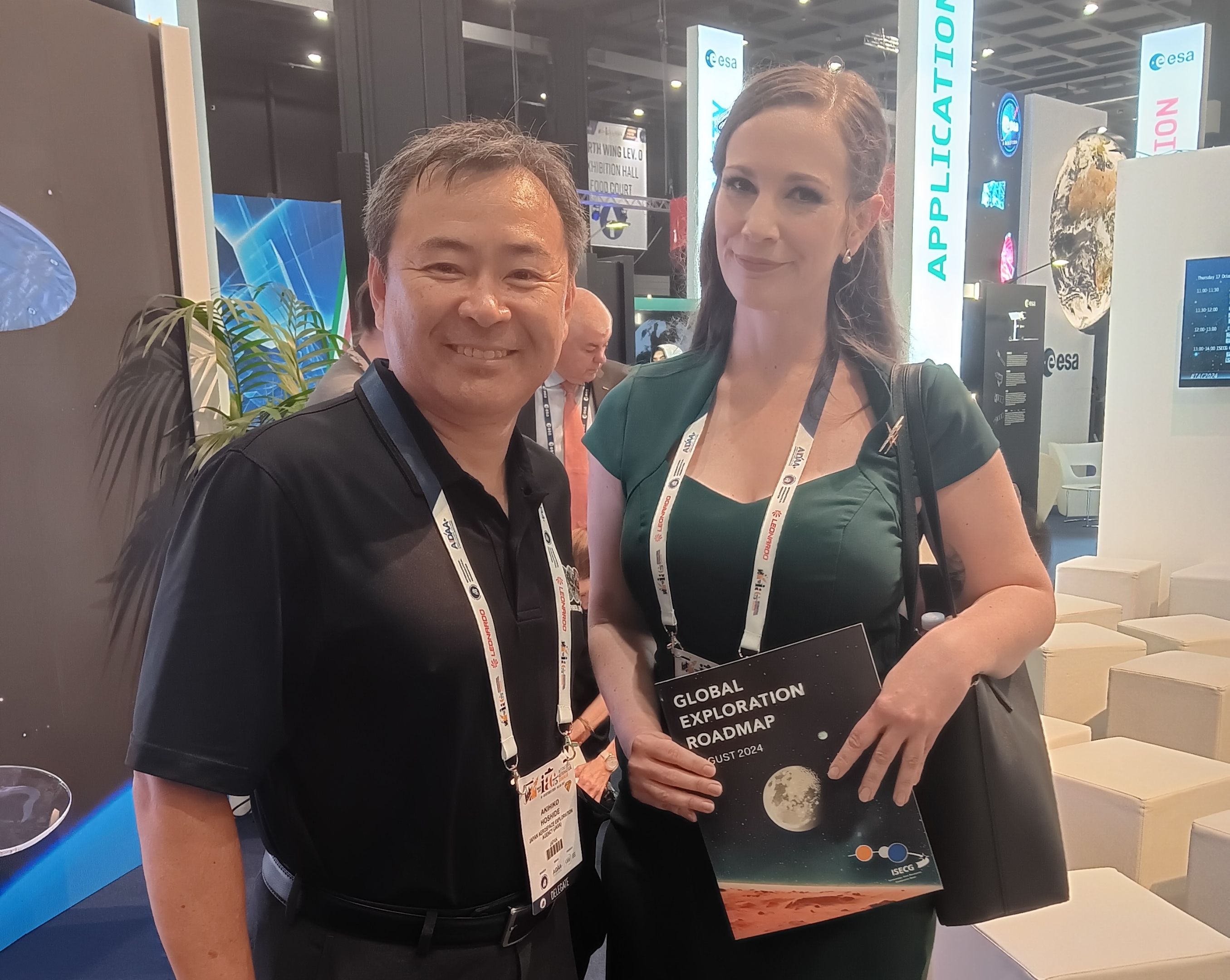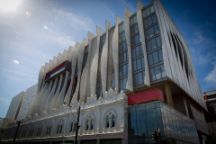Swinburne student presents lunar research at the 75th International Astronautical Congress

Erin Rose presenting her research at the International Astronautical Congress
In summary
Swinburne student Erin Rose recently presented her research on lunar lava tubes at the International Astronautical Congress in Milan
Her research investigates how naturally occurring lunar lava tubes can be used as shelters for future space habitats
The trip was funded by the CAS Alumni Fund which supports students in astrophysics and supercomputing through alumni donations
Swinburne Bachelor of Science student Erin Rose has recently presented her research at the 75th International Astronautical Congress (IAC) in Milan. Her research focuses on lunar lava tubes, which have the potential to serve as natural shelters for future space habitats.
Erin’s passion for space and her impressive research achievements led to her selection for this prestigious event, a rarity for undergraduate students. The trip was made possible through the CAS Alumni Fund, which supports students in astrophysics and supercomputing.
From passion to profession
Growing up, Erin has always had a keen interest in space but thought that a career in space exploration was out of reach in Australia. However, everything changed when she watched the SpaceX Crew-2 Dragon launch to the International Space Station during the pandemic lockdown.
“I imagined being able to contribute to space exploration in some way would be a rewarding and exciting challenge and started researching what Australia was doing in the space sector. I discovered that Swinburne offered a co-major in Space Technology, and I enrolled in the next semester!”
From day one, Erin found the teaching staff in the program incredibly supportive, creating opportunities to gain experience outside the classroom. She was able to contribute to experiments sent to the International Space Station through programs like SHINE and the Youth Space Innovation Challenge.
A defining moment at the IAC
Every year, the IAC brings together leaders, innovators, and scientists from around the world for five days of presentations and discussions on space exploration. The event offered an amazing opportunity for Erin to share her work with an international audience and receive valuable feedback.
“Presenting my research helped me gain confidence in communicating complex ideas effectively, and hearing feedback deepened my understanding of my field. I also came to appreciate how interdisciplinary work - integrating biology, geology, and engineering - is essential for addressing challenges in space exploration.”

Akihiko Hoshide (left) with Erin Rose (right) at the International Astronautical Congress
A highlight of her experience was a chance encounter with Akihiko Hoshide, a JAXA astronaut who flew on the Crew-2 Dragon mission. Meeting Hoshide was a full-circle moment for Erin, who credits the mission with sparking her decision to pursue a career in space.
“It was a really lovely full-circle moment, and I was honestly quite starstruck! It reaffirmed my passion for planetary science and strengthened my resolve to pursue a PhD.”
Erin is already looking ahead to her next project for the IAC in Sydney with the hope that her journey will inspire others to pursue careers in space exploration.
"I believe strongly in the idea that ‘you can’t be what you can’t see’" Erin says. "I’m passionate about encouraging and showing others how much there is to contribute to in STEM and space exploration.”
-
Media Enquiries
Related articles
-

- University
- Education
Swinburne shines in 2025 QS World University Rankings by Subject
Swinburne University of Technology has achieved a total of 17 subjects ranked in the latest QS World University Rankings by Subject 2025.
Thursday 13 March 2025 -

- Astronomy
- Technology
- Science
Swinburne’s Spotlight on STEM: A Night of Space Innovation with Shelli Brunswick
Swinburne University hosted a Spotlight on STEM event with space innovator Shelli Brunswick, exploring space technology, leadership, and career opportunities in the space industry
Friday 21 March 2025 -

- Technology
- Education
- Science
- University
New Australia-India joint research institute to advance energy, communications, materials and manufacturing technologies
Swinburne University of Technology and the Indian Institute of Technology Hyderabad (IITH) have launched the Swinburne-IITH Manufacturing, Materials, Energy and Communication Technologies (SIMMECT) Joint Research Institute, to drive impactful research and global collaboration on major technology challenges.
Monday 03 March 2025 -

- Health
- Science
Swinburne to boost AI-driven design for dental devices with investment in H3D
Swinburne has invested in spinout company H3D, a cutting-edge tech company that is reinventing custom-fit devices using AI and automation.
Monday 31 March 2025 -

- Science
- Sustainability
Swinburne joins global Green Steel Alliance to advance carbon-neutral ironmaking and steelmaking
Swinburne has become a founding member of the global Green Steel Alliance. The Green Steel Alliance brings together leading research and industry stakeholders from around the world to advance the transition to a green economy.
Wednesday 12 March 2025

